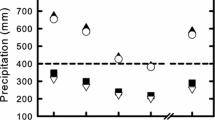Summary
Three species of Phlox (Polemoniaceae) were grown in 6 greenhouse treatments. A variety of traits were recorded and the correlations among them were computed for each treatment. The phenotypic correlations between characters are significantly altered when plants are grown under different environmental conditions. These changes in correlation structure result from the differential phenotypic plasticity of traits. Partial correlations between flower production and other traits are also environment-dependent. Such changes can alter the intensity of, and possibly the response to, selection on traits correlated with fitness in natural plant populations.
Similar content being viewed by others
References
Adams MW (1967) Basis of yield component compensation in crop plants with special reference to the field bean, Phaseolus vulgaris. Crop Sci 7:505–510
Antonovics J (1976) The nature of limits to natural selection. Ann Missouri Bot Gard 63:224–247
Ariyo OJ, Aken'ova ME, Fatokun CA (1987) Plant character correlations and path analysis of pod yield in okra (Abelmoschus esculentus). Euphyt 36:677–686
Berg RL (1960) The ecological significance of correlation pleiades. Evolution 14:171–180
Bradshaw AD (1965) Evolutionary significance of phenotypic plasticity in plants. Adv Genet 13:115–155
Cheverud JM (1982) Phenotypic, genetic, and environmental morphological integration in the cranium. Evolution 36:499–516
Clausen J, Hiesey WM (1958) Experimental studies on the nature of species. IV. Genetic structure of ecological races. Carnegic Inst Washington, Publ 615
Davis JI (1983) Phenotypic plasticity and the selection of taxonomic characters in Puccinellia. Syst Bot 8:341–353
Dragavtsev VA, Aver'yanova AF (1984a) Mechanism of genotype-environment interaction and homeostasis of quantitative characters in plants. Sov Genet 19:1420–1424
Dragavtsev VA, Aver'yanova AF (1984b) Redetermination of the genetic formulas of quantitative characters of wheat in different environmental conditions. Sov Genet 19:1424–1430
Dragavtsev VA, Utemisheva NV (1975) Ontogenetic variability of statistical genetic parameters in plant populations. I. Theory of the problem. Sov Genet 11:1456–1466
Falconer D (1981) Introduction to Quantitative Genetics, 2nd ed, Longman Inc, NY
Huhn M, Schuster W (1982) Einige experimentelle Ergebnisse über den Einfluß unterschiedlicher Konkurrenzsituationen auf die Korrelation zwischen Einzelpflanzenmerkmalen (Ertragskomponenten) bei Winterraps. Z Pflanzenzucht 89:60–73
Lande R, Arnold SJ (1983) The measurement of selection on correlated characters. Evolution 37:1210–1226
Lechowicz MJ, Blais PA (1988) Assessing the contributions of multiple interacting traits to plant reproductive success: environmental dependence. J Evol Biol 1:255–273
Leyna HK, Korban SS, Coyne DP (1982) Changes in patterns of inheritance of flowring time of dry beans in different environments. J Hered 73:306–308
Marshall DM, Jain SK (1968) Phenotypic plasticity of Avena fatua and A. barbata. Am Nat 102:457–467
Morisset P, Boutin C (1984) The biosystematic importance of phenotypic plasticity. In: Grant WF (ed) Plant biosystematics. Academic Press, Orlando, FL, pp 293–306
Morrison DF (1976) Multivariate Statistical Methods, 2nd ed, McGraw-Hill, NY
Primack RB, Antonovics J (1982) Experimental ecological genetics in Plantago. VII. Reproductive effort in populations of P. lanceolata L. Evolution 36:742–752
SAS User's Guide: Statistics (1985) SAS Inst., Cary, NC
Schlichting CD (1984) Studies on phenotypic plasticity in annual Phlox. Dissertation, University of Texas at Austin
Schlichting CD (1986) The evolution of phenotypic plasticity in plants. Ann Rev Ecol Syst 17:667–693
Schlichting CD, Levin DA (1984) Phenotypic plasticity in annual Phlox: tests of some hypotheses. Am J Bot 71:252–260
Schlichting CD, Levin DA (1986) Phenotypic plasticity: an evolving plant character. Biol J Linn Soc 29:37–47
Schnee FB, Thompson JN Jr (1984) Conditional neutrality of polygene effects. Evolution 38:42–46
Singh BP, Chowdhury RK (1983) Correlation and path coefficient analysis of seed yield and oil content in mustard Brassica juncea. Can J Gen Cytol 25:312–317
Sneath PHA, Sokal RR (1973) Principles of numerical taxonomy. WH Freeman, San Francisco, CA
Snedecor GW, Cochran WG (1980) Statistical Methods, 7th ed. Iowa State University Press, Ames, Iowa
Author information
Authors and Affiliations
Rights and permissions
About this article
Cite this article
Schlichting, C.D. Phenotypic plasticity in Phlox . Oecologia 78, 496–501 (1989). https://doi.org/10.1007/BF00378740
Received:
Issue Date:
DOI: https://doi.org/10.1007/BF00378740




